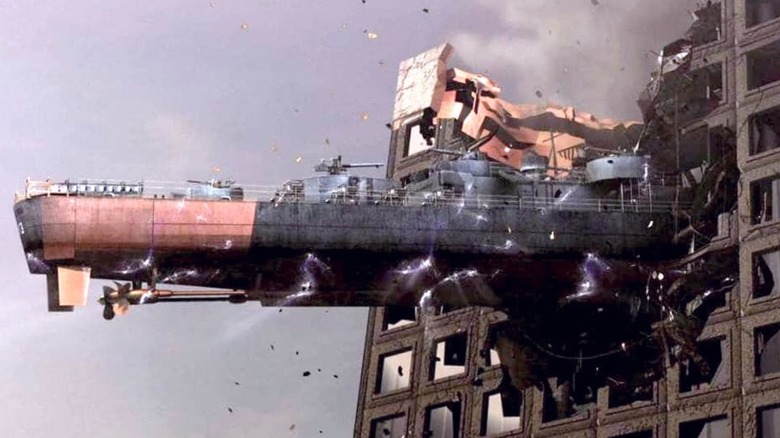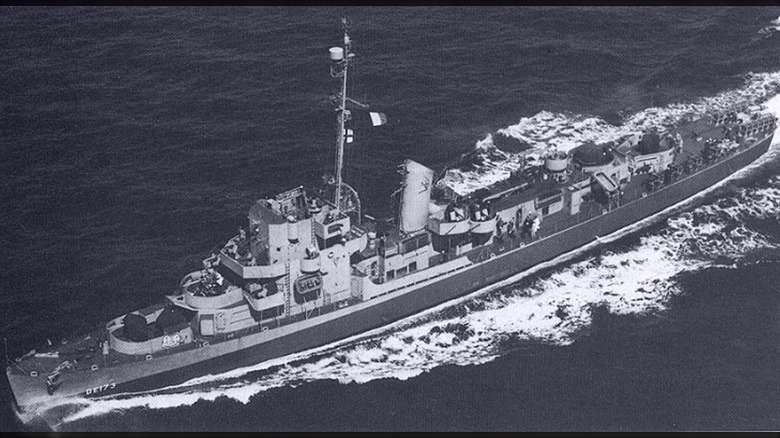The Philadelphia Experiment: What Really Happened To The Ship USS Eldridge?
Back in October 1943, a merchant seaman named Carl M. Allen allegedly witnessed something remarkable. The so-called "Philadelphia Experiment" is the story of how the U.S. Navy destroyer USS Eldridge (DE-173) was purportedly used as a test platform for a cloaking device that rendered it invisible for a short time. Allen's story is truly incredible, and it spawned a feature film, "The Philadelphia Experiment," which was released in 1984.
While some have heard the story and scoffed at it, others have believed Allen, and the tale of the Eldridge has permeated popular culture beyond the film. In Marvel's "Loki," the USS Eldridge can be seen in the Void, a place where all displaced things go at the end of time. Still, it's a fantastical tale, and many attempts to explain the science of what occurred in October 1943 have been made over the years. There was indeed a USS Eldridge, and Allen was an active merchant marine at the time.
While the story is incredible, and the impressive military warship existed, it's widely considered to be bunk. There's no evidence of any such experiment, and the Eldridge wasn't even in Philadelphia during the purported test. Still, the Philadelphia Experiment remains a popular supernatural story that's been passed around for decades. Here's what really happened to the USS Eldridge and some more details about the Philadelphia Experiment and how the story came into the world.
The Philadelphia Experiment
The Philadelphia Experiment first came to light in 1956 when Carl M. Allen sent a copy of a book on UFOs to the Office of Naval Research. Within the book were handwritten notes detailing a discussion between three people about alien technology. The following year, Allen sent letters to the author of the book, and it was in these correspondences that he made claims relating to a special test conducted at the Philadelphia Naval Shipyard in October 1943.
The experiment was supposedly conducted at the shipyard, where the USS Eldridge was made to disappear, but that wasn't what actually happened. According to the story, the Eldridge was teleported to Norfolk, Virginia, where it remained for a few minutes before returning to its original location. The experiment was conducted with the crew aboard, and the sailors didn't get through the event unscathed. Allen mentioned reports of insanity and other effects, like parts of crew members' bodies merging with the metal of the ship.
The story spread as more people became interested in Allen's claims, and his annotated book started being circulated. Eventually, the Philadelphia Experiment entered into popular culture, and it became another of those mysteries without an answer. In truth, Allen almost certainly made up the whole thing and spread a false story that went viral before going viral was a thing. Still, the USS Eldridge did exist, and it had a long service life in and out of the U.S. Navy.
The USS Eldridge (DE-173)
The USS Eldridge was a Navy destroyer, not to be confused with a frigate, which is somewhat similar. She was first launched in July 1943, and between January '44 and May '45, she escorted Allies to and from the Mediterranean Sea, supporting ongoing operations in Southern Europe and North Africa. Throughout this period, the Eldridge made nine crossings, helping ensure vital supplies, equipment, and personnel made it to the front. When the European conflict ended, the Eldridge served in the Pacific campaign, performing similar actions.
When the war ended, the U.S. Navy opted to place her out of commission. The Eldridge became a reserve vessel until she was transferred to Greece, given the name Leon, and was finally scrapped in 1999. In terms of her specifications, the Eldridge displaced 1,240 tons of seawater, measured 306 feet in length, and could sail up to 24 mph. A crew of 196 personnel served aboard the Eldridge, which boasted three 3-inch guns, three 21-inch torpedo tubes, depth charge projectors, and more.
The Eldridge served with distinction throughout her service history, earning numerous medals. It's unclear why Carl M. Allen decided the Eldridge would be the target of his tale, but there's absolutely no evidence to support his claims. Instead, it seems the USS Eldridge was a typical Cannon-class destroyer escort, which served the U.S. Navy throughout its time in WWII. While it was an important vessel, Allen's story is what made it a fixture in the history books, even if his story is little more than a tall tale.


